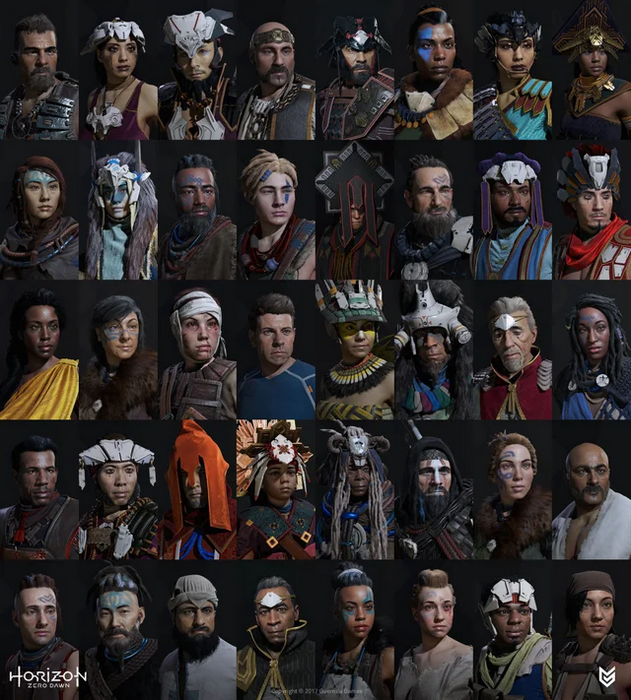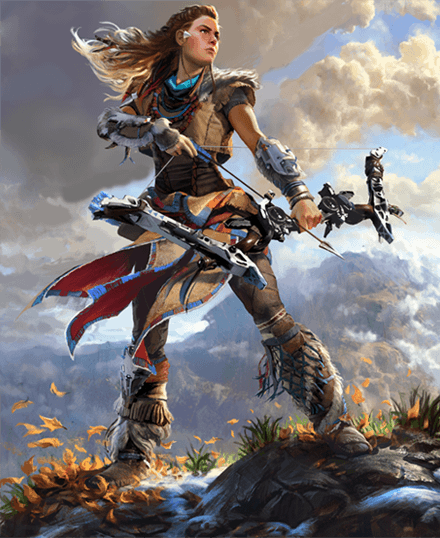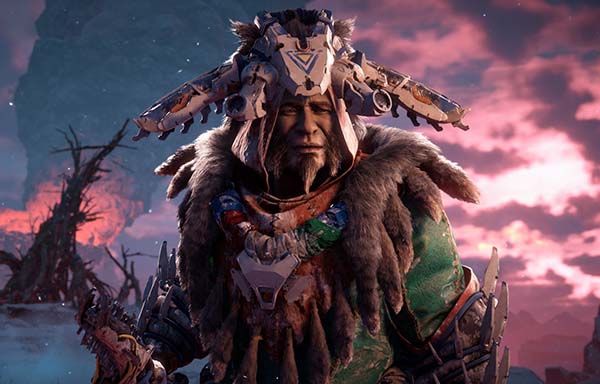Content note: This will contain minor spoilers only. No guarantees about the comment section.
Horizon: Zero Dawn is a 2017 video game that takes place in a post-apocalyptic world where robotic beasts roam the earth. The protagonist, Aloy, is an exile from the Nora, a tribe of hunter-gatherers. Aloy’s mission in life is to end her own exile, but as soon as she succeeds, she receives her call to adventure, and must venture out of Nora lands into Carja territory.
HZD has some genuinely interesting things to say about race, far surpassing my expectations for a big-budget video game. Here I will discuss how the game hits the mark on several issues. Then I’ll discuss how the game has been criticized for cultural appropriation of Native Americans. Finally, I will discuss my own criticism: Where the main game succeeds, the DLC pack The Frozen Wilds falls flat on its face.
Where Horizon: Zero Dawn succeeds
The first thing that stands out about HZD is its racially diverse cast. Behold:

Credit: AbyssOfUnknowing. These are all minor characters, because the image was challenging people to name as many characters as they could remember.
The racial diversity is justified within the story, because [spoiler redacted]. I mean, I’d expect there to be more intermixing until everyone’s racially ambiguous, but I accept the inconsistency because it’s just nice to have a game that’s about as diverse as my local area. I’m sure some gamers have complained about the racial diversity in HZD; I don’t care about them; moving on.
Although the cast is diverse in skin color, nobody ever remarks upon it. People don’t identify according to skin color, they don’t divide into groups based on skin color, they don’t have any stereotypes or narratives based on skin color. It’s not that they have no group divisions or stereotypes–they have all these things, they’re just not based on skin color. Instead, they are based on nationality. One of the very first things that you learn about any character, is whether they are Nora, Carja, Oseram, or Banuk. The Carja see themselves as civilized, and the Nora as savages. The Nora see the Carja as murderers and warmongers, because the Carja invaded them a decade ago. Both the Carja and Nora see themselves as the chosen people of their own god.
What this tells you is that racial/ethnic divisions are not, on a fundamental level, about skin color at all. It is about visible markers that create social divisions, be it skin color or something else. In this world, race is not white, black, asian, and latinx. Race is Nora, Carja, Oseram and Banuk. And this is not too far off from how race/ethnicity is seen in many parts of the world. I am reminded of my analysis of Xenoblade Chronicles X, where I learned that the Japanese conception of ethnic diversity centers on nationalities: Japanese, Chinese, Korean, Russian, and American.
At the beginning of the game, NPCs always refer to Aloy as “outcast”, because she is exiled from the tribe. Later, she earns another title of respect among the Nora. But once she travels into Carja lands, she loses all that, becoming simply “Nora”. She often remarks on this flattening of her own identity, saying she doesn’t even identify that strongly with the Nora, having been exiled from birth. This is highly relatable to many second-generation immigrants and mixed-race people, who often don’t identify that strongly with their ethnic heritage, and may not even like aspects of their ethnic heritage. And yet, in a white-dominated context, our ethnic heritage is what most people see. So we have to figure out what that means for us, and forge our own identities.
Another aspect of the story, is that the Carja are strongly coded as a colonial power. They’re the ones with the technology, the cities, and the power to subjugate neighbors. If the Carja had the power, they would certainly want to convert the Nora to their “enlightened” sun-worshipping religion.
What feels great about this game is that it takes an anti-colonialist perspective, and subverts white savior narratives. Instead of focusing on a “civilized” character who goes in among the natives and solves all their problems, we focus on Aloy, from the “savage” east. As she travels through Carja lands, we see through their superiority complex. We see their patriarchal society, bloodthirsty history, and xenophobia. Of course, we are not necessarily hostile to the Carja, and Aloy reserves criticism for the Nora as well. In particular, she doesn’t think much of their religion, their isolationism, or their practice of exiling people from birth.
My one qualm is that, going by skin color, Aloy is white. And while skin color doesn’t matter in her universe, obviously it matters from the perspective of the player. If she were of color, that would have reinforced the game’s subversion of the white savior narrative. But since she is white it takes away from the narrative, to the extent that many critics miss it.
Native American coding
Upon HZD’s release, one criticism was that it was appropriating from Native Americans. The Nora seem inspired by Native Americans, in terms of their dress, cultural markers, and the terminology used to refer to their social structures. In particular, the game frequently uses the words “tribe”, “savage”, “primitive”, and “brave”. (The Nora also draw inspiration from other native cultures, but it might not matter if many players only see the Native American coding.)

Credit: Guerrilla Games
There are several articles discussing this issue, although mostly they just boil down to a link to this article by Dia Lacina, and the response from the game’s narrative director.
With all due respect to Dia Lacina, her article doesn’t so much explain what is wrong, it simply points to the problem and says that it is a problem. In my reading, Lacina is calling for people to do their own research–which the journalists won’t do, because they’re just sharing other people’s content instead of creating their own. For instance, I initially didn’t understand what was wrong with the Nora referring to their warriors as “braves”. Lacina doesn’t say! And Wikipedia only mentions this usage of “brave” in its disambiguation page. I eventually learned that “Brave” refers to a set of traditional racist imagery of “noble savage” men. Well now I see why people might have a problem with that!
I really don’t like summarizing the argument as simply “cultural appropriation”. “Cultural appropriation” is a highly non-specific category, spanning the gamut from good, to harmless, to bad, to downright evil. And because it is non-specific, it is non-persuasive. I strongly prefer more specific and informative arguments, such as, “The use of ‘brave’ brings to mind traditional racist imagery of Native Americans.” Or, “Our understanding of Native Americans is dominated by imagery created by white people, erasing the experiences of Native Americans in the present day.” So, it doesn’t matter if the Nora are portrayed in a positive way, you’re still thinking of Native Americans as an isolated and less technologically advanced society, instead of thinking of them as a marginalized group that is still around today.
So, I understand why people might have an issue with the Nora being coded as Native American. That said, I think the game’s anti-colonialist narrative is worthwhile, and it seems difficult to write such a story without at least some Native American coding, intentional or otherwise.
White saviorism in The Frozen Wilds
The Frozen Wilds is a DLC pack that takes Aloy to Banuk territory. The way of life of the Banuk has been disrupted because a bunch of dangerous robots flooded out of a smouldering volcano. One of the Banuk wants to investigate, but the chieftain won’t allow it, so Aloy ends up fighting for the chieftain title.
Like the Nora, the Banuk are coded as a native group of people, although they’re native to a much colder region. To my eyes, the Banuk are given more of a unique look, prominently featuring metal headdresses and what appear to be blue nylon piercings. Also, they don’t have “tribes”, they have “weraks”. So, if you didn’t like the Native American coding in the Nora, the Banuk could be a very slight improvement.

Credit: Guerrilla Games. This is the werak chieftain you replace. Okay, so the Native American coding still seems obvious.
But I would argue that the Banuk are far more problematic than the Nora, because of what happens in the story. In the main game, Aloy is a hero from the “savage” Nora (who aren’t really savage, it’s just that the local colonial power seems to think so) venturing into colonial territory. In The Frozen Wilds, Aloy is a hero who goes into native lands, and uses her superior technology to save them from their own suffocating cultural traditions and religion. And despite knowing nothing about how to run a werak, she somehow becomes chieftain of one, and does it better than the previous chieftain. WTF?
In short, the story of the main game is a subversion of the white savior narrative, but the story of the DLC hits the white savior narrative note for note. I was shocked by the about-face. The DLC is otherwise good, but were the writers sleeping at the wheel? It goes to show that, yes, you can have a story where skin color is effectively randomized, but which still reinforces colonial narratives.

I’ve been replaying H:ZD recently, so I guess I’ll chime in with my 2 cents.
I don’t really know the proper vernacular for discussing cultural appropriation, but I always felt the Native American/First Nation parallels were a little too “on the nose”. Had they swapped out a few ideas with stuff inspired from other cultures, it wouldn’t had been as bad. Personally I think the Nora eschew technology and are “all natural” (a popular trope about Native Americans) is so the game can justify you having the lowest power weapons/armor at the beginning of the game. I really love the idea of that type of culture in a world where robots roam the earth and are therefore part of nature, so I’m glad they did that, even if it’s just a sop to game mechanics. I like the Nora culture as a whole (in a literary sense), so it’s difficult to say what I would change.
Also, you forgot another theme that comes up repeatedly in Aloy’s adventures among the Carja. Economic inequality. The Carja are a culture where the nobles live in luxury, while everybody else who isn’t a successful merchant or tradesperson just scrapes by. They also don’t strike me as expansionist/colonists. The biggest issue the Oseram and Nora have them isn’t them taking other people’s land, but raiding them to get sacrifices to the Sun (The Carja definitely remind me of Aztec/Mayan culture and the Aztecs were known for doing just that). It’s a pretty expansive world, but I didn’t meet anybody who complained about how their village was taken over by the Carja. Just that their army showed up and killed/took people.
I completely missed the “white savior” part of the Banuk DLC as I concentrated more on defeating the new robots and learning about the Banuk to pay much attention to what Aloy was doing, so I hope you haven’t completely ruined it for me when I make another run of it ;p.
@drken,
The developers claim that the Nora also drew inspiration from other groups like the Vikings, and I found at least one guy arguing that angle. But this defense is a tough sell to me because, as a player I don’t look at the Nora and think Vikings, I think Native Americans–and I think I’m typical in this regard. Maybe I just don’t know what Vikings look like. Do Vikings also have an “all natural” thing going on? Seems doubtful.
And yeah, the economic inequality. I hadn’t really been thinking about that part in my playthrough, but it was definitely present. I’m not sure the game had much to say on that point though, there were just poor people, and rich people, and Aloy was often helping the poor. There was that one quest where a nobleman has her track down a thief, and it turns out the thief was desperately poor.
Manual pingback: this article was cited in a video essay about settler colonialism in video games.